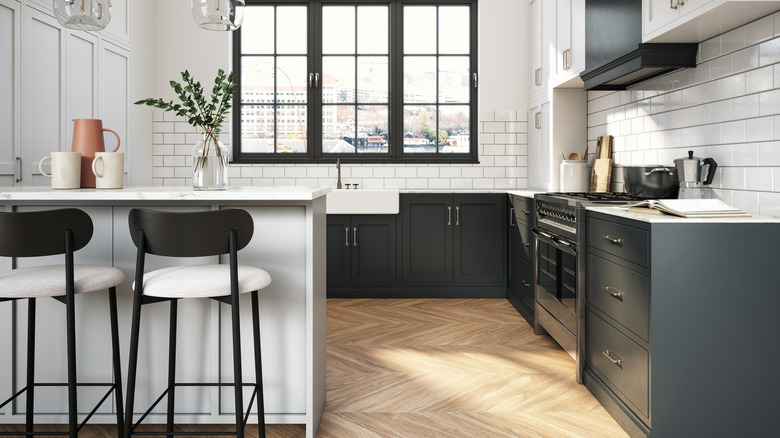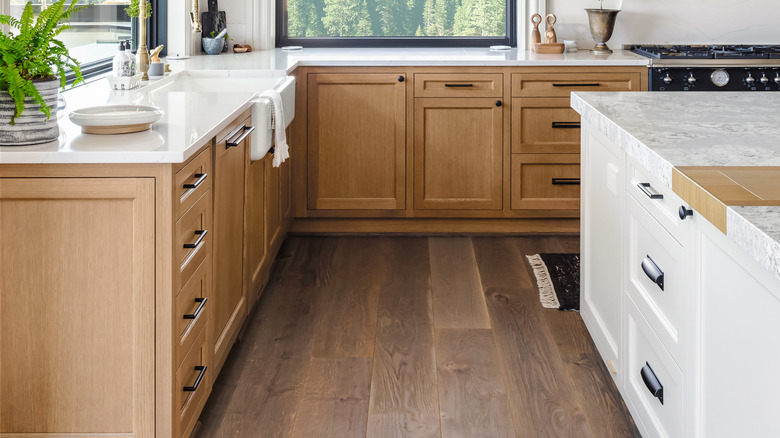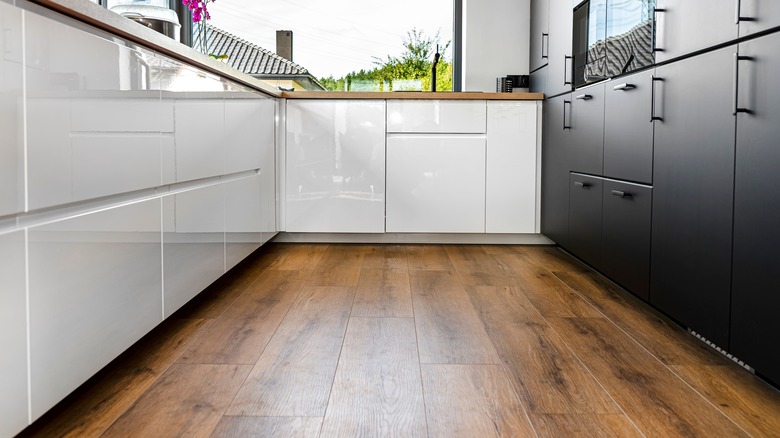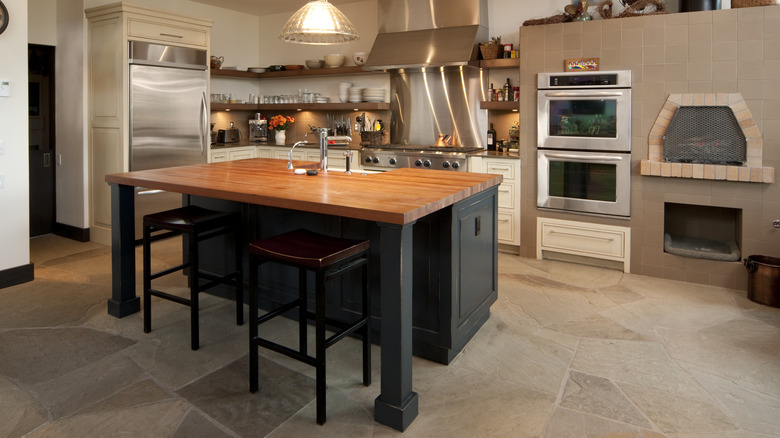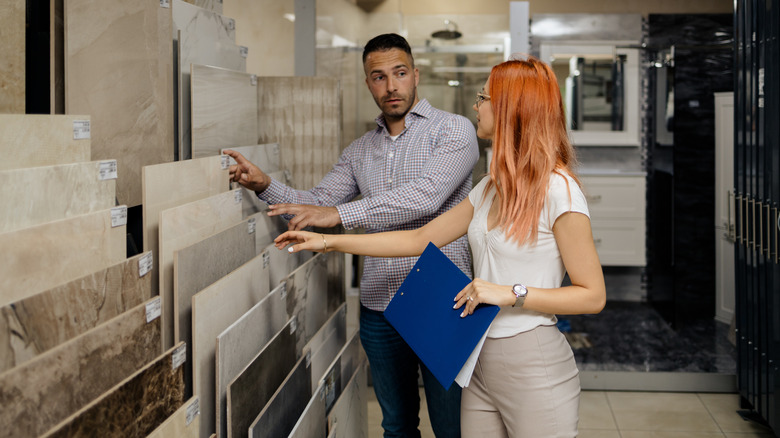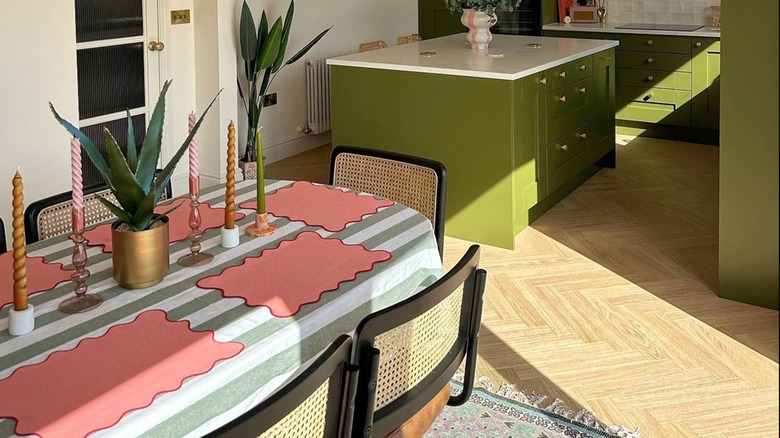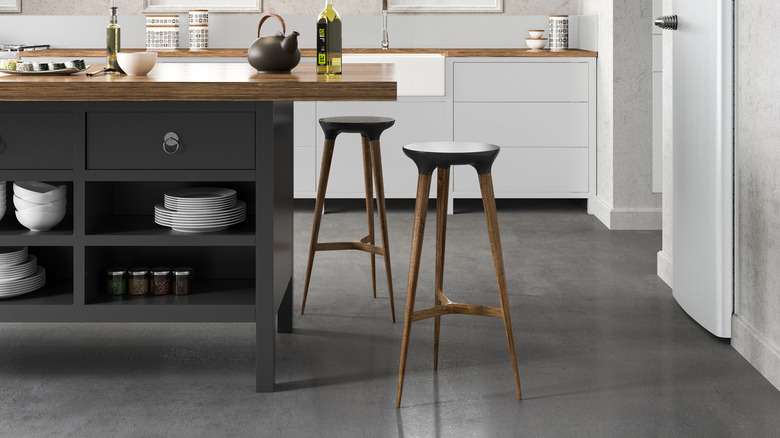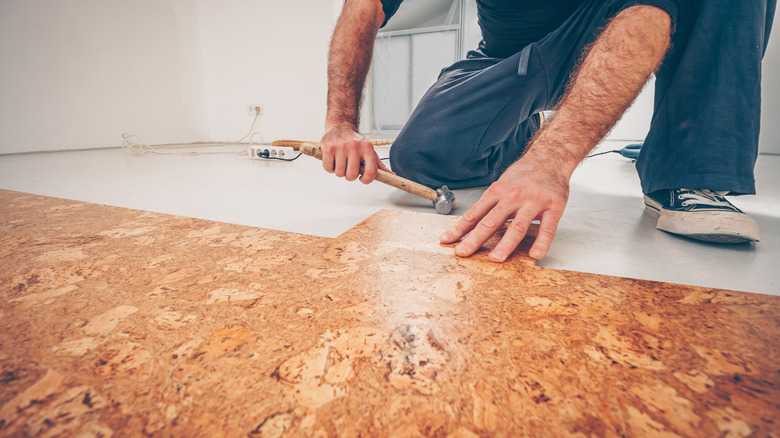The 7 Best Flooring Options For The Kitchen
When it comes to your kitchen flooring, different households will have different needs. However, there are some things everyone should consider. First is durability. The kitchen is a naturally high-traffic area, even if you live alone. Because of this, the floor you choose should be able to stand up to the challenge. Varying types of flooring will have different targeted resistances. Only you know the most common type of mark or spill in your kitchen, but you can never go wrong with moisture and stain-resistant flooring.
Live a busy life? Only check out low-maintenance floor options. High-maintenance floor options may look beautiful, but there's no point in splashing out on expensive flooring that ends up getting dusty and tired only a few years in. Finally, there's price. Budget is a huge factor in kitchen flooring, but don't worry if you have a smaller one. There are plenty of attractive, yet inexpensive, flooring options out there. The following kitchen flooring types — hardwood, vinyl, laminate, porcelain tile, natural stone tile, concrete, and cork — all possess one or more of the above qualities that makes them particularly good choices for a busy space like the kitchen.
Hardwood flooring
Looking for a kitchen floor that will stand up against high foot traffic and whatever life throws at it? Enter: the hardwood floor. Though not traditionally waterproof, this type of flooring can be made water-resistant, and several options are now pre-treated to save you having to seal the floor yourself. However, this does not mean you should let spillages sit around — if there's an excess of water on the floor, mop it up to prevent it from seeping into the wood.
Aesthetically, hardwood floor ranges from light to dark, so you don't have to settle for an in-between shade if you have your heart set on a particular look. Best of all, it can actually be switched up relatively easily. Rather than having to uproot the whole floor, you can choose to bleach or re-stain your existing hardwood flooring for a brand new look. Moreover, if you like to do your bit for the planet, there are plenty of reclaimed and recycled hardwood flooring options available nowadays.
Vinyl flooring
If you're looking for a flooring option that's within your budget, and has a variety of patterns, look no further than vinyl. Speaking to Homes & Gardens, hard flooring expert David Snazel shared, "Vinyl is a great and inexpensive way to add color, pattern and personality to kitchen flooring ideas without compromising on safety or quality. Being highly durable, slip-resistant and moisture proof, it is ideal for busy households with young children."
As well as the affordable price point of vinyl flooring, it's also low maintenance, making it ideal if you want something that only requires a quick dust, sweep, and mop. Plus, like Snazel mentioned, the high durability of vinyl means it will stand up against marks from pets and small children — which is great for a high-traffic area like the kitchen. Unless you literally drop a sharp knife from a high distance, your vinyl floor will keep looking brand new. You don't have to sacrifice on design, either. Vinyl has a slight reputation for being unfashionable, but nowadays there are heaps of styles to choose from that can emulate many textures, including wood and stone.
Natural stone tile
Natural stone tile may not be the first flooring option you think of for the kitchen, but it is one of the best when it comes to impact and heat resistance. Of course, stone isn't one style fits all. Different types of stone will offer various benefits — hard stone is best for general durability, whereas a softer stone could be a better option if you like something less taxing on the feet. Some of the most popular types of stone flooring include granite, slate, limestone, and sandstone.
A popular choice for countertops, too, granite is known for its durability (if cared for properly). Sandstone will feel softer underfoot and is a good option if you want a look that's out of the ordinary. Limestone has the same softness as sandstone, but with an attractively cool look to it. Both of these options, though, are less durable due to their softness. Finally, slate is extremely hard-wearing, and will bring an elegant vibe to your kitchen.
No matter which stone you choose, keep in mind that it will have to be sealed to make it resistant to liquid spills. You should aim to reseal around every three to four years. While this means natural stone tile isn't quite low-maintenance, it's still a solid option if the above task isn't an issue for you.
Porcelain tiles
Not only does it look stunning, but porcelain tile flooring is also highly resistant to stains. It comes in a range of design choices, too. Per House Beautiful, designer Emily Black shared, "There's also lots of grouting colour options now. Mid-dark colours work better on floors as dirt can get ingrained." Borders can also be added for a little extra something. Unlike other types of tile, porcelain can be made to look like plenty of other materials you may like, but aren't quite as durable — for example, marble.
As mentioned, porcelain is naturally stain-resistant, meaning it's a solid low-maintenance option. Nevertheless the grout in-between tiles is not resistant, and you'll need to seal it to prevent future issues. Moreover, if you live in a cold area, bear in mind that porcelain tiles will not keep the heat in. In fact, they could make your kitchen feel colder, although if you have underfloor heating this won't necessarily be an issue. Not all porcelain tiles are created equal, so don't try to use porcelain tiles made for a wall on your floor — they often don't have the same durability and aren't designed for heavy foot traffic.
Laminate flooring
Unlike hardwood or porcelain tile, laminate floor is constructed from several different materials. It is typically made using particle board, a base, a middle layer, and a final layer on top for protection. Because of this top layer, laminate flooring is an excellent choice for your kitchen if you want something that won't show wear and tear even after lots of foot traffic. Much like vinyl, laminate can be made to look like several different types of flooring, allowing you to get the look of a wood floor without the hassle or upkeep. Laminate is also generally a lot less expensive than the flooring it can be made to look like.
Plus, you can install laminate flooring relatively easily by yourself even if you're not a seasoned DIY-er due to the fact it doesn't require any nailing or gluing to a layer underneath. Though it's low maintenance, one potential downside of laminate is that the boards will warp if exposed to too much moisture. Because of this, you should sweep regularly and mop with a small amount of water only semi-regularly.
Concrete flooring
If you want a flooring option that can withstand scratches up to an impressive degree, concrete floor could be right for your space. There are two ways to install this flooring: pour the concrete over an existing floor layer, or use it as the only layer. Polished concrete is popular for a more elegant look, and also comes in several colors. However, matte concrete is better at disguising any flaws that do occur.
Despite it being durable against scratches, note that concrete floor is not low-maintenance, as it has the potential to crack and even crumble in hot, humid weather. If you do spot any signs of damage, concrete is also on the pricier side to get fixed. Additionally, you may want to rethink installing concrete floor if you live with children or clumsy pets. Its durability means it isn't a forgiving surface to fall on. Finally, if you opt for high quality concrete flooring, it can quickly add up. Prices range from $15 to $30 per square foot, depending on texture and finishes. Concrete flooring may not be the best choice for all households, but if it works for your lifestyle and budget, it's definitely a cool and unique option.
Cork flooring
If you want flooring that's eco-friendly, cork is a great choice. Plus, in addition to it being kind to the environment, cork won't max out your budget. On average, it costs around $3 to $7 per square foot. Cork flooring also has a naturally springy, cushioned feel to it, so it'll be comfortable on your feet. As for the look of cork, it can give your home a ranch or barn-style look. Though it only comes in one style, cork naturally varies in color and pattern, similar to hardwood, so you don't have to worry about it being boring.
When it comes to caring for cork, proper maintenance is essential to prevent your flooring from becoming scratched or losing its shape. Sweeping and mopping on a regular basis are key, but, like with laminate, you should never use a sopping wet mop. Too much water will saturate the cork and damage it. Plus, cork will show stains relatively easily, so it's best to remove a mark as soon as you spot it to stop it setting in. Finally, though it has plenty of plus points, cork's coloring will fade if exposed to direct sunlight repeatedly, so it would be best suited for a kitchen that doesn't get ample sun exposure.
